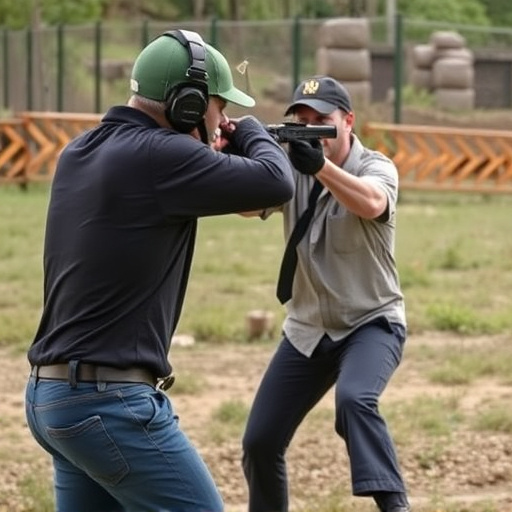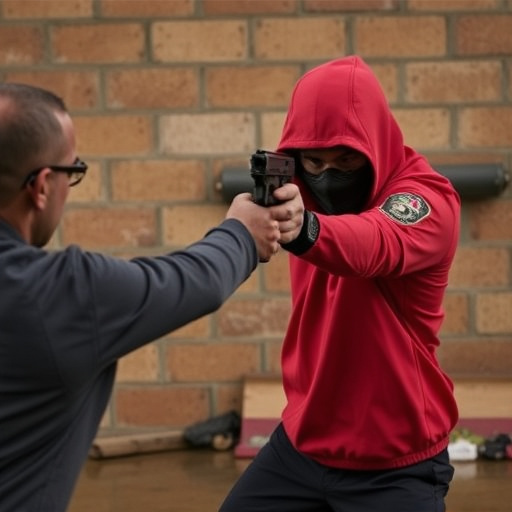For newcomers to stun guns, understanding amperage is crucial for safe self-defense. Stun guns with adjustable amperage settings and built-in safety features, like automatic shut-offs and LED indicators, offer control over shock intensity while minimizing harm (50,000–150,000 amps). Comprehensive manuals and training programs educate users on responsible handling, de-escalation tactics, and local laws, ensuring effective yet safe use of stun guns with safety features for beginners.
“Electrical shock weapons, particularly stun guns, have gained attention as personal defense tools. This article delves into the crucial aspect of amperage—the electrical current that delivers a powerful yet safe shock. We explore ‘understanding amperage in stun guns,’ highlighting the role of safety features and their significance for users’ protection. Furthermore, we guide beginners through choosing the right amperage and debunking common misconceptions. By adhering to responsible use guidelines, individuals can ensure their safety and the effectiveness of their stun gun with built-in safety features.”
- Understanding Amperage in Stun Guns
- Safety Features: Protecting Users and Others
- Choosing the Right Amperage for Beginners
- Misconceptions About Electrical Shock Weapons
- Training and Responsible Use Guidelines
Understanding Amperage in Stun Guns

Amperage is a critical factor to understand when considering stun guns, especially for beginners looking into self-defense tools equipped with safety features. Stun guns use electrical current to deliver a powerful shock, and this current is measured in amperage (A). The higher the amperage, typically the more intense the stun effect. However, it’s essential to grasp that while higher amperage can increase effectiveness, it also raises the risk of potential side effects and safety concerns.
Stun guns with built-in safety features often come with amperage ranges designed to incapacitate without causing severe harm. Beginners should opt for models that offer adjustable amperage settings, allowing them to customize the shock level based on situations and comfort levels. This flexibility ensures users can deploy the stun gun effectively while mitigating risks, making it a practical choice for personal safety.
Safety Features: Protecting Users and Others

Stun guns equipped with safety features are designed to protect both users and others, making them ideal for beginners looking to learn self-defense. These devices incorporate various mechanisms to ensure responsible use. One common feature is an automatic shut-off function that disengages the weapon after a set stun duration or when the trigger is released, preventing accidental or prolonged shocks. Additionally, many stun guns come with safety switches, requiring users to activate them before firing, adding an extra layer of control.
Some models even integrate digital controls and LED indicators, providing clear visual cues about battery life, activation status, and shock intensity. These advanced features promote safe handling, ensuring users understand the device’s capabilities and limitations. Such safeguards are particularly crucial for beginners who may require guidance on proper usage while building confidence in their ability to defend themselves effectively.
Choosing the Right Amperage for Beginners

When it comes to selecting an electrical shock weapon, especially for beginners, choosing the right amperage is paramount for both effectiveness and safety. Stun guns with safety features designed for novice users typically offer a lower amperage range, usually between 50,000 and 150,000 amps. This lower range ensures that users can incapacitate an assailant without causing severe or permanent harm, making them ideal for self-defense scenarios.
For beginners, it’s crucial to opt for a weapon with a clear safety mechanism, such as a trigger lock or a smart chip that limits the amperage output when the trigger is pulled. These features prevent accidental high-voltage discharges, ensuring user safety and peace of mind. Additionally, many stun guns designed for first-time users come with comprehensive user manuals, highlighting safe handling practices to further mitigate risks associated with electrical shock weapons.
Misconceptions About Electrical Shock Weapons

There are many misconceptions surrounding stun guns and their effectiveness as personal defense tools. One common misunderstanding is that any electrical shock weapon can instantly incapacitate an attacker, which isn’t always the case. Stun guns with safety features for beginners are designed to disrupt muscle control temporarily, not to cause severe or permanent harm. The amperage (current) delivered is typically lower than many people assume, often ranging from 50,000 to 150,000 volts, ensuring users can deter an attacker without risking serious injury.
Another misconception is that stun guns are foolproof and cannot be blocked or resisted. In reality, strategic blocking or muscle contractions can reduce the effectiveness of a shock, especially in close-quarters combat. Stun guns with safety features cater to beginners by incorporating design elements that mitigate these risks, such as automatic shut-off mechanisms after each discharge, preventing accidental multiple shocks, and compact sizes for easy carrying and handling.
Training and Responsible Use Guidelines

For beginners using stun guns, proper training and responsible handling are paramount. Many modern stun devices come equipped with safety features designed to mitigate risks associated with electrical shock weapons. These may include adjustable amperage settings, allowing users to deliver tailored levels of force based on specific situations and threat assessments. Additionally, training programs often emphasize the importance of understanding local laws, safe storage practices, and proper use techniques to ensure effectiveness while minimizing potential harm.
Responsible use guidelines encourage individuals to only deploy stun guns as a last resort for self-defense. Beginners should be taught to assess each scenario carefully, considering alternative options and de-escalation tactics before resorting to electrical shock. Regular practice sessions under expert supervision can help users become more comfortable with their devices and confident in their ability to employ them safely and effectively when needed.
Stun guns, when used responsibly, can be powerful tools for self-defense. Understanding amperage, or the amount of electrical current flowing through a circuit, is key to choosing the right stun gun for your needs. Safety features, such as those designed to prevent accidental discharge and protect users from harm, are crucial for beginners. By selecting a suitable amperage level and adhering to training and responsible use guidelines, you can ensure that stun guns serve their purpose effectively while minimizing risks. Always remember to prioritize safety when considering any electrical shock weapon, especially with the right amperage, these devices can provide peace of mind in potentially dangerous situations.
